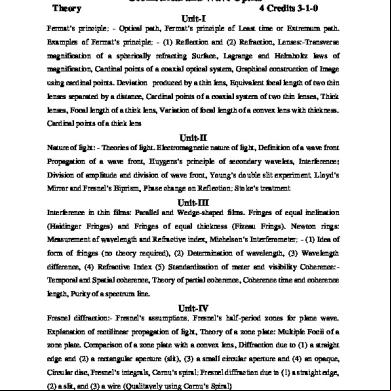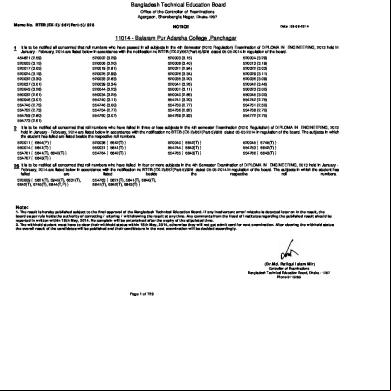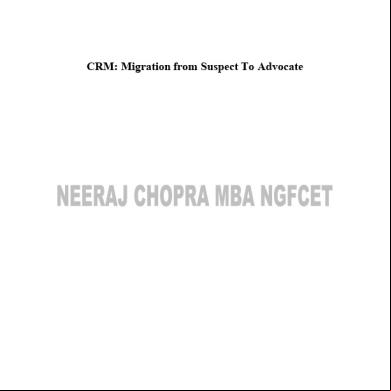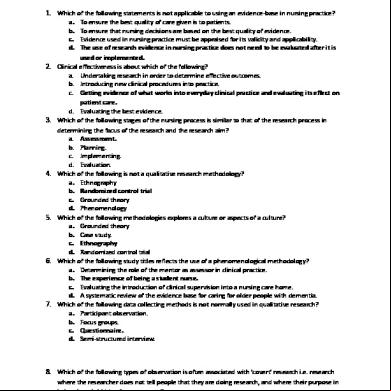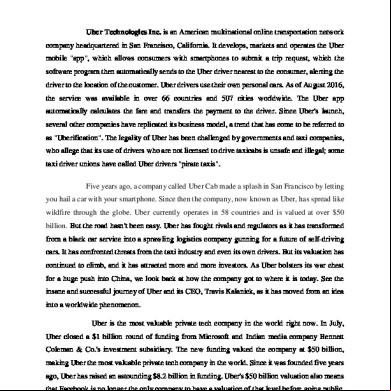4th Semester 5q3k4g
This document was ed by and they confirmed that they have the permission to share it. If you are author or own the copyright of this book, please report to us by using this report form. Report 3b7i
Overview 3e4r5l
& View 4th Semester as PDF for free.
More details w3441
- Words: 2,256
- Pages: 12
Semester IV IPH-251 Physics-IV Geometrical and Wave Optics Theory
4 Credits 3-1-0 Unit-I
Fermat’s principle: - Optical path, Fermat’s principle of Least time or Extremum path. Examples of Fermat’s principle: - (1) Reflection and (2) Refraction, Lenses:-Transverse magnification of a spherically refracting Surface, Lagrange and Helmholtz laws of magnification, Cardinal points of a coaxial optical system, Graphical construction of Image using cardinal points. Deviation produced by a thin lens, Equivalent focal length of two thin lenses separated by a distance, Cardinal points of a coaxial system of two thin lenses, Thick lenses, Focal length of a thick lens, Variation of focal length of a convex lens with thickness. Cardinal points of a thick lens
Unit-II Nature of light: - Theories of light. Electromagnetic nature of light, Definition of a wave front Propagation of a wave front, Huygens’s principle of secondary wavelets, Interference: Division of amplitude and division of wave front, Young’s double slit experiment. Lloyd’s Mirror and Fresnel’s Biprism, Phase change on Reflection: Stoke’s treatment
Unit-III Interference in thin films: Parallel and Wedge-shaped films. Fringes of equal inclination (Haidinger Fringes) and Fringes of equal thickness (Fizeau Frings). Newton rings: Measurement of wavelength and Refractive index, Michelson’s Interferometer: - (1) Idea of form of fringes (no theory required), (2) Determination of wavelength, (3) Wavelength difference, (4) Refractive Index (5) Standardization of meter and visibility Coherence:Temporal and Spatial coherence, Theory of partial coherence, Coherence time and coherence length, Purity of a spectrum line.
Unit-IV Fresnel diffraction:- Fresnel’s assumptions. Fresnel’s half-period zones for plane wave. Explanation of rectilinear propagation of light, Theory of a zone plate: Multiple Focii of a zone plate. Comparison of a zone plate with a convex lens, Diffraction due to (1) a straight edge and (2) a rectangular aperture (slit), (3) a small circular aperture and (4) an opaque, Circular disc, Fresnel’s integrals, Cornu’s spiral: Fresnel diffraction due to (1) a straight edge, (2) a slit, and (3) a wire (Qualitavely using Cornu’s Spiral)
Unit V Diffraction due to (1) a single slit, (2) a double slit and (3) a plane transmission grating, Rayleigh’s criterion of resolution, Resolving power and Dispersive power of a plane diffraction grating, Principle of Holography, Recording and Reconstruction method, Theory of Holography as Interference between two plane waves.
Suggested Books:1. Fundamental of Optics by Francis Arthur Jenkins and Harvey Elliott White (McGrawHill, 1976) 2. Optics by Ajay Ghatak (Tata McGraw Hill, 2008 ) 3. Optics by Eugene Hecht and AR Ganesan (Pearson Education, 2002 ) 4. Light and Optics : Principles and Practices by Abdul Al- Azzawi (CRC Press, 2007) 5. Contemporary Optics by A.K. Ghatak & K. Thyagarajan. (Plenum Press, 1978) 6. Introduction to Optics by Khanna and Gulati
IPH-253: Quantum Mechanics-I Theory
4 Credits 3-1-0 Unit-I
Inadequacies in Classical Physics, Blackbody Radiation: Quantum Theory of Light. Photoelectric Effect, Compton Effect, Franck- Hertz experiment. Wave Nature of Matter: De Broglie Hypothesis, Wave – Particle Duality, Davisson - Germer Experiment, Two Slit Experiment with Electrons, Probability, Wave Amplitude and Wave Functions.
Unit-II Basic Postulates and Formalism: Energy, Momentum and Hamiltonian Operators, TimeIndependent Schrodinger Wave Equation for Stationary States, Properties of Wave Function, Probability Density and Probability, Conditions for Physical Acceptability of wave Functions, Normalization, Linearity and Superposition Principles, Eigen values and Eigen functions, Expectation Values, Wave Function of a Free Particle.
Unit-III Normalized one and three dimension wave packets, Wave description of Particles by Wave Packets, Group and Phase Velocities and Relation between them, Schwartz’s inequality uncertainty principle, Application of uncertainty principle, Expectation values of physical observables and dynamical quantities, Ehrenfest theorem, Bohr’s correspondence principle, Principle of complementarity, coordinate and momentum representations, Significances of momentum wave function.
Unit-IV Eigen Functions and Eigen values for a Particle in a One Dimensional Box, Bound State Problems:- General Features of a Bound Particle System, (1) One Dimensional Simple Harmonic oscillator: Energy Levels and Wave Functions. Zero Point Energy, (2) Quantum Theory of Hydrogen Atom: Particle in a Spherically Symmetric Potential, Schrodinger Equation, Separation of Variables, Radial Solutions and Principal Quantum Number, Orbital and Magnetic Quantum Numbers, Quantization of Energy and Angular Momentum, Space Quantization, Electron Probability Density, Radiative Transitions, Selection Rules.
Unit-V Scattering Problems in One Dimension :- (1) Finite Potential Step: Reflection and Transmission. Stationary Solutions, Probability Current, Attractive and Repulsive Potential Barriers. (2) Quantum Phenomenon of
Tunnelling:
Tunnel
(Qualitative Description) (3) Finite Potential Well (Square Well).
Effect.
Tunnel
Diode
Suggested Books:1. Quantum Mechanics by L. I. Schiff, , 3rd Edition, ( McGraw Hill Bool Co. New York 1968). 2. Quantum Mechanics by E. Merzbacher, 3rd Edition, (John Wiley & Sons, Inc 1997) 3. Quantum Mechanics by J. L. Powell & B. Crasemann, (Addition- Welsey Pubs. Co., 1965) 4. Quantum Mechanics: Theory and Applications by A. Ghatak & S. Lokanathan, , 5th Edition, (Macmillan India, 2004) 5. Quantum Mechanics: Non – Relativistic Theory Course of Theoretical Physics, Vol 3) by E.M. Lifshitz and L. D. Landau, 3rd Edition, Butterworth – Heinemann (1981). 6. Quantum Mechanics: Foundations and Applications by Arno Bohm----3rd Edition ----- (New York: Springer- VerIag, 2003).
IPHL-291: Optics Lab IV Practical
4Credits 0-0-8
1: Reflection, Refraction and Dispersion (i)
To determine the Refractive Index of the Material of a given Prism using Sodium Light.
(ii)
To determine the Refractive Index of a Liquid by Total Internal Reflection using Wollaston’s Air- film.
(iii)
To determine the Refractive Index of (1) Glass and (2) a Liquid by total Internal Reflection using a Gaussian Eyepiece.
(iv)
To determine the Dispersive Power of the Material of a given Prism using Mercury Light.
(v)
To determine the Value of Cauchy Constants.
(vi)
To determine the Resolving Power of a Prism.
2: Interference (i)
To determine wavelength of Sodium light using Fresnel Biprism.
(ii)
To determine wavelength of Sodium light using Newton’s Rings.
(iii)
To determine the Thickness of a Thin Paper by measuring the Width of the Interference Fringes produced by a Wedge-Shaped Film.
(iv)
To determination Wavelength of Sodium Light Michelson’s Interferometer.
3. Diffraction (i)
To determine the Diameter of a Thin Wire by Studying the Diffraction Produced by it.
(ii)
To determine the wavelength of Laser Light using Diffraction of Single Slit.
(iii)
To determine the wavelength of (1) Sodium and (2) Mercury Light using Plane Diffraction Grating.
(iv)
To determine the Dispersive Power of a Plane Diffraction Grating.
(v)
To determine the Resolving Power of a Plane Diffraction Grating.
(vi)
To determine the (1)Wavelength and (2)Angular Spread of He-Ne Laser using Plane
(vii)
Diffraction Grating
To study the Polarization of Light by Reflection and to determine the Polarizing Angle for air- glass interface.
(viii)
To measure the intensity using Photosensor and Laser in diffraction patterns of single and double slits.
Suggested Books: 1. B. Sc Practical Physics, by Geeta Sanon, R. Chand &Co 1 st Edn. (2007) 2. Advanced Practical Physics, by B. L. Workshop and H.T. Flint, Asia Publishing House, New Delhi 3. A Text Book of Practical Physics by Indu Prakash and Ramakrishna, KItab Mahal, New Delhi. 4. A Laboratory Manual of Physics for Undergraduate Classes by D.P. Khandewal, Vani Publication House, New Delhi. 5. Practical Physics by Nelson and Jon Ogborn.
IPHL-292: Advanced Electronics Lab Practical
4 Credits: 0-0-8
1. Networks (i)
To the Thevenin, Norton, Superposition, and Maximum Power Transfer Theorem.
(ii)
To measure the Input and Output Impedance of an Unknown Network and to convert n into Equivalent T and Pi Circuits.
2. Power Supply (i)
To study (a) Half – wave Rectifier and (b) Full Bridge Rectifier and investigate the effect of C, L and 𝜋 filters.
(ii)
To design a Semiconductor Power Supply of given rating using (a) Half wave, (b) Full wave or (c) Bridge rectifier and investigate the effect of C- filter.
(iii)
To study the Forward and Reserves characteristics of a Zener Diode and to study its use a Voltage Regulator.
(iv)
To investigate simple regulation and stabilization circuits using Voltage Regulator ICs.
3. Transducers (i)
To determine the Characteristics of p-n junction of a Solar Cell.
(ii)
To study the Characteristics of Photo-diode.
(iii)
To determine the Coupling Coefficient of a piezoelectric crystal.
4. Transistor Applications (i)
To study the CE Characteristics of Transistor.
(ii)
To study the various Transistor Biasing Configurations.
(iii)
To design the CE Amplifier of a given gain (mid- gain) using Voltage Divider Bias.
(iv)
To design the Frequency Response of Voltage Gain of a RC- Coupled Amplifier
(v)
To design an Oscillator of given specifications using Transistors.
(vi)
To study the Characteristics of a FET and design a common source amplifier.
Suggested Books 1. BSc Practical Geeta Sanon, 1st Edn. (2007), R. Chand & Co. 2. Practical Physics Nelson and Jon Ogborn, 3. Experiments in Modern Physics by Adrian C. Melissinos, Jim Napolitano,. 4. Basic Electronics (A Text- Lab Manual), Paul B. Zbar and Albert B. Malvino, Tata McGraw Hill. 5. Analog Electronics by A.P. Malvino, and John Morris,. 6. Digital Principles and Apllications by AP Malvino and DP Leach.
Semester IV Analog Electronics Theory
4 Credits 3-1-0 Unit-I
Diode Circuits: Ideal diode, piecewise linear equivalent circuit, dc load line analysis, Quiescent (Q) point, positive, negative and biased clipper circuits, clamping circuits. Half wave rectifier, centre tapped and bridge full wave rectifiers, calculation of efficiency and ripple factor. DC power supply: Block diagram of a power supply, qualitative description of shunt capacitor filter, Zener diode as voltage regulator, temperature coefficient of Zener diode.
Bipolar Junction Transistor Unit-II The BJT: transistor current components and amplification. Transistor configurations: Common Base (CB), Common Emitter (CE), and Common Collector (CC) configuration, IV characteristics and hybrid parameters, regions of operation, dc load line, Q point. Hybrid equivalent of CE, Quantitative study of the frequency response of CE amplifier, effect on gain and bandwidth for cascaded CE amplifier (RC coupled).
Unit-III Amplifiers: Concept of , negative and positive , Negative : advantages and disadvantages of negative , voltage (series and shunt), current (series and shunt) amplifiers, derivation of gain, input and output impedances for amplifiers. Positive : Barkhausen criteria for oscillations, study of phase shift oscillator and Colpitts oscillator. Colpitts crystal oscillator.
Unit-IV The MOSFET: The three configurations: Common Gate (CG), Common Source (CS), Common Drain (CD), I-V characteristic, regions of operations, small signal equivalent circuit, dc load line, Q point. CS amplifier: CS amplifier circuit analysis, Qualitative study of the frequency response of CS amplifier.
Unit-V
Basic Operational Amplifier: Concept of differential amplifier, block diagram of an operational amplifier (IC 741), Op-Amp parameters: input offset voltage, input offset current, input bias current, differential input resistance, input capacitance, offset voltage adjustment range, input voltage range, common mode rejection ratio, slew rate, supply voltage rejection ratio. Suggested Books:1. R.L. Boylestad, L. Nashelsky, K.L. Kishore, Electronic Devices and Circuit Theory, Pearson Education (2006) 2. D.L. Schilling and C. Belove, Electronic Circuits: Discrete and Integrated, Tata McGraw Hill (2002) 3. J.R.C. Jaegar and T.N. Blalock, Microelectronic circuit design, Tata McGraw Hill (2010) 4. Donald A. Neaman, Electronic Circuit Analysis and Design, Tata McGraw Hill (2002) 5. J. Millman and C.C. Halkias, Integrated Electronics, Tata McGraw Hill (2001) 6. J.J. Cathey, 2000 Solved Problems in Electronics, Schaum’s Outline Series, Tata McGraw Hill (1991)
Semester IV Mathematical-IV 4 Credits 3-1-0 Unit-I Differential Equations: classification-ordinary and partial, order and degree, linear and nonlinear, homogeneous and non-homogeneous; solution: explicit and implicit, number of arbitrary constants; linear ordinary differential equation: first order: (1) separable equations, initial value problem, (2) exact equation- integrating factor.
Unit-II Linear equation, Lagrange’s method of variation of parameter; second order: homogeneous equations with constant coefficients. Wronskian and general solution, statement of existence and uniqueness theorem for initial value problems, solution of non-homogeneous equations by D operator method, particular integral.
Unit-III Methods of undetermined coefficient and variation of parameters, equations reducible to those with constant coefficient, Bernoulli and Euler equations, coupled differential equations: solution by method of elimination.
Unit-IV Calculus of Variation: variational calculus-variational principle, Euler’s equation and its applications to simple problem, Geodesics, concept of Lagrangian, generalized coordinates, definition of canonical momenta, Euler-Lagrange’s equations of motion and its applications to simple problems, (e.g., simple pendulum and one dimensional harmonic oscillator).
Unit-V Definition of canonical momenta, canonical pair of variables, definition of generalized force, definition Hamiltonian (legendre transformation), Hamilton’s principle, poisson brackets and their properties, constrained maxima and minima, Lagrange’s method of undetermined multipliers and its applications to simple problems in physics.
Suggested Books:1. N. M. Kapoor, A Text Book of Differential Equations (Pitambar Publishing). 2. Richard Bronson, Schaum’s outline of theory and problems of differential equations, (McGraw Hill). 3. Erwin Kreyszig, Advanced Engineering Mathematics (Wiley Eastern Limited). 4. B. S. Grewal, Higher Engineering Mathematics, Khanna Publishers.
Semester IV Principles of Management 4 Credits 3-1-0 Unit-I Introduction: Concept, Nature, Characteristics, Functions and Significance of management.
Unit-II Planning: Meaning, Objectives and Process of Planning, Management by objectives, Decision Making- Concepts, Types and Process.
Unit-III Organizing: Meaning, Objectives, Significance, principles and forms of Organization. Centralization and Decentralization of Authority, Staffing-
Meaning, Significance and
Process.
Unit-IV Directing: Nature, Importance, Principles, Coordinating – nature, importance and principles, Communication – Meaning, types and process. Motivation - Meaning and Definition, Importance, Types. Leadership – Meaning and Definition, Principles, Importance and Types of Leadership.
Unit-V Controlling: Meaning, Objective, Importance, Limitations, Principles and Process of Controlling.
Suggested Books:1. Drucker Peter F: Management Challenges for 21st Century; Butterworth Heinmann, Oxford 2. Stoner and Freeman: Management; Prentice Hall, New Delhi 3. Hampton, David R: Modern Management, McGraw Hill, New York 4. Louis A. Allen: Management and Organisation, McGraw Hill, Tokyo 5. Fred Luthans: Organisational Behaviour, McGraw Hill, New York 6. Weihrich and Koontz, et al: Essential of Management, Tata McGraw Hill, New Delhi
4 Credits 3-1-0 Unit-I
Fermat’s principle: - Optical path, Fermat’s principle of Least time or Extremum path. Examples of Fermat’s principle: - (1) Reflection and (2) Refraction, Lenses:-Transverse magnification of a spherically refracting Surface, Lagrange and Helmholtz laws of magnification, Cardinal points of a coaxial optical system, Graphical construction of Image using cardinal points. Deviation produced by a thin lens, Equivalent focal length of two thin lenses separated by a distance, Cardinal points of a coaxial system of two thin lenses, Thick lenses, Focal length of a thick lens, Variation of focal length of a convex lens with thickness. Cardinal points of a thick lens
Unit-II Nature of light: - Theories of light. Electromagnetic nature of light, Definition of a wave front Propagation of a wave front, Huygens’s principle of secondary wavelets, Interference: Division of amplitude and division of wave front, Young’s double slit experiment. Lloyd’s Mirror and Fresnel’s Biprism, Phase change on Reflection: Stoke’s treatment
Unit-III Interference in thin films: Parallel and Wedge-shaped films. Fringes of equal inclination (Haidinger Fringes) and Fringes of equal thickness (Fizeau Frings). Newton rings: Measurement of wavelength and Refractive index, Michelson’s Interferometer: - (1) Idea of form of fringes (no theory required), (2) Determination of wavelength, (3) Wavelength difference, (4) Refractive Index (5) Standardization of meter and visibility Coherence:Temporal and Spatial coherence, Theory of partial coherence, Coherence time and coherence length, Purity of a spectrum line.
Unit-IV Fresnel diffraction:- Fresnel’s assumptions. Fresnel’s half-period zones for plane wave. Explanation of rectilinear propagation of light, Theory of a zone plate: Multiple Focii of a zone plate. Comparison of a zone plate with a convex lens, Diffraction due to (1) a straight edge and (2) a rectangular aperture (slit), (3) a small circular aperture and (4) an opaque, Circular disc, Fresnel’s integrals, Cornu’s spiral: Fresnel diffraction due to (1) a straight edge, (2) a slit, and (3) a wire (Qualitavely using Cornu’s Spiral)
Unit V Diffraction due to (1) a single slit, (2) a double slit and (3) a plane transmission grating, Rayleigh’s criterion of resolution, Resolving power and Dispersive power of a plane diffraction grating, Principle of Holography, Recording and Reconstruction method, Theory of Holography as Interference between two plane waves.
Suggested Books:1. Fundamental of Optics by Francis Arthur Jenkins and Harvey Elliott White (McGrawHill, 1976) 2. Optics by Ajay Ghatak (Tata McGraw Hill, 2008 ) 3. Optics by Eugene Hecht and AR Ganesan (Pearson Education, 2002 ) 4. Light and Optics : Principles and Practices by Abdul Al- Azzawi (CRC Press, 2007) 5. Contemporary Optics by A.K. Ghatak & K. Thyagarajan. (Plenum Press, 1978) 6. Introduction to Optics by Khanna and Gulati
IPH-253: Quantum Mechanics-I Theory
4 Credits 3-1-0 Unit-I
Inadequacies in Classical Physics, Blackbody Radiation: Quantum Theory of Light. Photoelectric Effect, Compton Effect, Franck- Hertz experiment. Wave Nature of Matter: De Broglie Hypothesis, Wave – Particle Duality, Davisson - Germer Experiment, Two Slit Experiment with Electrons, Probability, Wave Amplitude and Wave Functions.
Unit-II Basic Postulates and Formalism: Energy, Momentum and Hamiltonian Operators, TimeIndependent Schrodinger Wave Equation for Stationary States, Properties of Wave Function, Probability Density and Probability, Conditions for Physical Acceptability of wave Functions, Normalization, Linearity and Superposition Principles, Eigen values and Eigen functions, Expectation Values, Wave Function of a Free Particle.
Unit-III Normalized one and three dimension wave packets, Wave description of Particles by Wave Packets, Group and Phase Velocities and Relation between them, Schwartz’s inequality uncertainty principle, Application of uncertainty principle, Expectation values of physical observables and dynamical quantities, Ehrenfest theorem, Bohr’s correspondence principle, Principle of complementarity, coordinate and momentum representations, Significances of momentum wave function.
Unit-IV Eigen Functions and Eigen values for a Particle in a One Dimensional Box, Bound State Problems:- General Features of a Bound Particle System, (1) One Dimensional Simple Harmonic oscillator: Energy Levels and Wave Functions. Zero Point Energy, (2) Quantum Theory of Hydrogen Atom: Particle in a Spherically Symmetric Potential, Schrodinger Equation, Separation of Variables, Radial Solutions and Principal Quantum Number, Orbital and Magnetic Quantum Numbers, Quantization of Energy and Angular Momentum, Space Quantization, Electron Probability Density, Radiative Transitions, Selection Rules.
Unit-V Scattering Problems in One Dimension :- (1) Finite Potential Step: Reflection and Transmission. Stationary Solutions, Probability Current, Attractive and Repulsive Potential Barriers. (2) Quantum Phenomenon of
Tunnelling:
Tunnel
(Qualitative Description) (3) Finite Potential Well (Square Well).
Effect.
Tunnel
Diode
Suggested Books:1. Quantum Mechanics by L. I. Schiff, , 3rd Edition, ( McGraw Hill Bool Co. New York 1968). 2. Quantum Mechanics by E. Merzbacher, 3rd Edition, (John Wiley & Sons, Inc 1997) 3. Quantum Mechanics by J. L. Powell & B. Crasemann, (Addition- Welsey Pubs. Co., 1965) 4. Quantum Mechanics: Theory and Applications by A. Ghatak & S. Lokanathan, , 5th Edition, (Macmillan India, 2004) 5. Quantum Mechanics: Non – Relativistic Theory Course of Theoretical Physics, Vol 3) by E.M. Lifshitz and L. D. Landau, 3rd Edition, Butterworth – Heinemann (1981). 6. Quantum Mechanics: Foundations and Applications by Arno Bohm----3rd Edition ----- (New York: Springer- VerIag, 2003).
IPHL-291: Optics Lab IV Practical
4Credits 0-0-8
1: Reflection, Refraction and Dispersion (i)
To determine the Refractive Index of the Material of a given Prism using Sodium Light.
(ii)
To determine the Refractive Index of a Liquid by Total Internal Reflection using Wollaston’s Air- film.
(iii)
To determine the Refractive Index of (1) Glass and (2) a Liquid by total Internal Reflection using a Gaussian Eyepiece.
(iv)
To determine the Dispersive Power of the Material of a given Prism using Mercury Light.
(v)
To determine the Value of Cauchy Constants.
(vi)
To determine the Resolving Power of a Prism.
2: Interference (i)
To determine wavelength of Sodium light using Fresnel Biprism.
(ii)
To determine wavelength of Sodium light using Newton’s Rings.
(iii)
To determine the Thickness of a Thin Paper by measuring the Width of the Interference Fringes produced by a Wedge-Shaped Film.
(iv)
To determination Wavelength of Sodium Light Michelson’s Interferometer.
3. Diffraction (i)
To determine the Diameter of a Thin Wire by Studying the Diffraction Produced by it.
(ii)
To determine the wavelength of Laser Light using Diffraction of Single Slit.
(iii)
To determine the wavelength of (1) Sodium and (2) Mercury Light using Plane Diffraction Grating.
(iv)
To determine the Dispersive Power of a Plane Diffraction Grating.
(v)
To determine the Resolving Power of a Plane Diffraction Grating.
(vi)
To determine the (1)Wavelength and (2)Angular Spread of He-Ne Laser using Plane
(vii)
Diffraction Grating
To study the Polarization of Light by Reflection and to determine the Polarizing Angle for air- glass interface.
(viii)
To measure the intensity using Photosensor and Laser in diffraction patterns of single and double slits.
Suggested Books: 1. B. Sc Practical Physics, by Geeta Sanon, R. Chand &Co 1 st Edn. (2007) 2. Advanced Practical Physics, by B. L. Workshop and H.T. Flint, Asia Publishing House, New Delhi 3. A Text Book of Practical Physics by Indu Prakash and Ramakrishna, KItab Mahal, New Delhi. 4. A Laboratory Manual of Physics for Undergraduate Classes by D.P. Khandewal, Vani Publication House, New Delhi. 5. Practical Physics by Nelson and Jon Ogborn.
IPHL-292: Advanced Electronics Lab Practical
4 Credits: 0-0-8
1. Networks (i)
To the Thevenin, Norton, Superposition, and Maximum Power Transfer Theorem.
(ii)
To measure the Input and Output Impedance of an Unknown Network and to convert n into Equivalent T and Pi Circuits.
2. Power Supply (i)
To study (a) Half – wave Rectifier and (b) Full Bridge Rectifier and investigate the effect of C, L and 𝜋 filters.
(ii)
To design a Semiconductor Power Supply of given rating using (a) Half wave, (b) Full wave or (c) Bridge rectifier and investigate the effect of C- filter.
(iii)
To study the Forward and Reserves characteristics of a Zener Diode and to study its use a Voltage Regulator.
(iv)
To investigate simple regulation and stabilization circuits using Voltage Regulator ICs.
3. Transducers (i)
To determine the Characteristics of p-n junction of a Solar Cell.
(ii)
To study the Characteristics of Photo-diode.
(iii)
To determine the Coupling Coefficient of a piezoelectric crystal.
4. Transistor Applications (i)
To study the CE Characteristics of Transistor.
(ii)
To study the various Transistor Biasing Configurations.
(iii)
To design the CE Amplifier of a given gain (mid- gain) using Voltage Divider Bias.
(iv)
To design the Frequency Response of Voltage Gain of a RC- Coupled Amplifier
(v)
To design an Oscillator of given specifications using Transistors.
(vi)
To study the Characteristics of a FET and design a common source amplifier.
Suggested Books 1. BSc Practical Geeta Sanon, 1st Edn. (2007), R. Chand & Co. 2. Practical Physics Nelson and Jon Ogborn, 3. Experiments in Modern Physics by Adrian C. Melissinos, Jim Napolitano,. 4. Basic Electronics (A Text- Lab Manual), Paul B. Zbar and Albert B. Malvino, Tata McGraw Hill. 5. Analog Electronics by A.P. Malvino, and John Morris,. 6. Digital Principles and Apllications by AP Malvino and DP Leach.
Semester IV Analog Electronics Theory
4 Credits 3-1-0 Unit-I
Diode Circuits: Ideal diode, piecewise linear equivalent circuit, dc load line analysis, Quiescent (Q) point, positive, negative and biased clipper circuits, clamping circuits. Half wave rectifier, centre tapped and bridge full wave rectifiers, calculation of efficiency and ripple factor. DC power supply: Block diagram of a power supply, qualitative description of shunt capacitor filter, Zener diode as voltage regulator, temperature coefficient of Zener diode.
Bipolar Junction Transistor Unit-II The BJT: transistor current components and amplification. Transistor configurations: Common Base (CB), Common Emitter (CE), and Common Collector (CC) configuration, IV characteristics and hybrid parameters, regions of operation, dc load line, Q point. Hybrid equivalent of CE, Quantitative study of the frequency response of CE amplifier, effect on gain and bandwidth for cascaded CE amplifier (RC coupled).
Unit-III Amplifiers: Concept of , negative and positive , Negative : advantages and disadvantages of negative , voltage (series and shunt), current (series and shunt) amplifiers, derivation of gain, input and output impedances for amplifiers. Positive : Barkhausen criteria for oscillations, study of phase shift oscillator and Colpitts oscillator. Colpitts crystal oscillator.
Unit-IV The MOSFET: The three configurations: Common Gate (CG), Common Source (CS), Common Drain (CD), I-V characteristic, regions of operations, small signal equivalent circuit, dc load line, Q point. CS amplifier: CS amplifier circuit analysis, Qualitative study of the frequency response of CS amplifier.
Unit-V
Basic Operational Amplifier: Concept of differential amplifier, block diagram of an operational amplifier (IC 741), Op-Amp parameters: input offset voltage, input offset current, input bias current, differential input resistance, input capacitance, offset voltage adjustment range, input voltage range, common mode rejection ratio, slew rate, supply voltage rejection ratio. Suggested Books:1. R.L. Boylestad, L. Nashelsky, K.L. Kishore, Electronic Devices and Circuit Theory, Pearson Education (2006) 2. D.L. Schilling and C. Belove, Electronic Circuits: Discrete and Integrated, Tata McGraw Hill (2002) 3. J.R.C. Jaegar and T.N. Blalock, Microelectronic circuit design, Tata McGraw Hill (2010) 4. Donald A. Neaman, Electronic Circuit Analysis and Design, Tata McGraw Hill (2002) 5. J. Millman and C.C. Halkias, Integrated Electronics, Tata McGraw Hill (2001) 6. J.J. Cathey, 2000 Solved Problems in Electronics, Schaum’s Outline Series, Tata McGraw Hill (1991)
Semester IV Mathematical-IV 4 Credits 3-1-0 Unit-I Differential Equations: classification-ordinary and partial, order and degree, linear and nonlinear, homogeneous and non-homogeneous; solution: explicit and implicit, number of arbitrary constants; linear ordinary differential equation: first order: (1) separable equations, initial value problem, (2) exact equation- integrating factor.
Unit-II Linear equation, Lagrange’s method of variation of parameter; second order: homogeneous equations with constant coefficients. Wronskian and general solution, statement of existence and uniqueness theorem for initial value problems, solution of non-homogeneous equations by D operator method, particular integral.
Unit-III Methods of undetermined coefficient and variation of parameters, equations reducible to those with constant coefficient, Bernoulli and Euler equations, coupled differential equations: solution by method of elimination.
Unit-IV Calculus of Variation: variational calculus-variational principle, Euler’s equation and its applications to simple problem, Geodesics, concept of Lagrangian, generalized coordinates, definition of canonical momenta, Euler-Lagrange’s equations of motion and its applications to simple problems, (e.g., simple pendulum and one dimensional harmonic oscillator).
Unit-V Definition of canonical momenta, canonical pair of variables, definition of generalized force, definition Hamiltonian (legendre transformation), Hamilton’s principle, poisson brackets and their properties, constrained maxima and minima, Lagrange’s method of undetermined multipliers and its applications to simple problems in physics.
Suggested Books:1. N. M. Kapoor, A Text Book of Differential Equations (Pitambar Publishing). 2. Richard Bronson, Schaum’s outline of theory and problems of differential equations, (McGraw Hill). 3. Erwin Kreyszig, Advanced Engineering Mathematics (Wiley Eastern Limited). 4. B. S. Grewal, Higher Engineering Mathematics, Khanna Publishers.
Semester IV Principles of Management 4 Credits 3-1-0 Unit-I Introduction: Concept, Nature, Characteristics, Functions and Significance of management.
Unit-II Planning: Meaning, Objectives and Process of Planning, Management by objectives, Decision Making- Concepts, Types and Process.
Unit-III Organizing: Meaning, Objectives, Significance, principles and forms of Organization. Centralization and Decentralization of Authority, Staffing-
Meaning, Significance and
Process.
Unit-IV Directing: Nature, Importance, Principles, Coordinating – nature, importance and principles, Communication – Meaning, types and process. Motivation - Meaning and Definition, Importance, Types. Leadership – Meaning and Definition, Principles, Importance and Types of Leadership.
Unit-V Controlling: Meaning, Objective, Importance, Limitations, Principles and Process of Controlling.
Suggested Books:1. Drucker Peter F: Management Challenges for 21st Century; Butterworth Heinmann, Oxford 2. Stoner and Freeman: Management; Prentice Hall, New Delhi 3. Hampton, David R: Modern Management, McGraw Hill, New York 4. Louis A. Allen: Management and Organisation, McGraw Hill, Tokyo 5. Fred Luthans: Organisational Behaviour, McGraw Hill, New York 6. Weihrich and Koontz, et al: Essential of Management, Tata McGraw Hill, New Delhi
